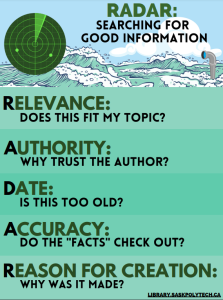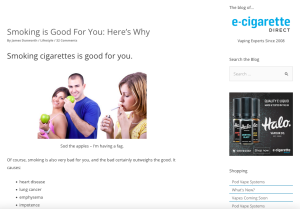5.5 Checklists
For decades, information professionals have created ways for people to see the difference between ‘good’ and ‘bad’ information online. Over time, they have developed and tested various frameworks for evaluating individual websites. A framework is a guide for what to do. For example, a recipe might be considered a framework for cooking dinner. One of the most popular frameworks is to use a checklist, which is easy to teach, easy to understand and easy to use. A checklist tells a person to take note of specific parts of a website, ask important questions, and decide if the website should be trusted based on the answer to those questions. Here is an example of a checklist:
|
Website Credibility Checklist |
||
|
|
Yes |
No |
|
The website creator is trustworthy |
|
X |
|
There are spelling errors on the website |
X |
|
|
There are broken links on the website |
|
X |
|
Is the website a good source of trustworthy information? |
|
X |
Library professionals have created many different checklists to help students evaluate information; generally, they all perform the same function. We will focus on RADAR .
5.5.1 RADAR
RADAR suggests considering 5 things when looking at a website: Relevance, Authority, Date, Accuracy and Reason for creation. Relevance is the most important element. An information source may be great but if it doesn’t fulfill the searcher’s goal, it isn’t very helpful. For instance, an article that presents medical research pertaining to carcinoma growth among patients in a clinical study published in a medical journal, might not be the correct reading level for the average person wanting to learn more about the risks of using a vape pen. Authority considers the expertise of the creator and whether they can be trusted to provide unbiased, quality information on a research topic. Date looks at when a piece of information was published and if it is current based on the research topic. If it is a field that changes quite frequently, such as technology or health, it is better to pick sources that have been published recently. Accuracy asks whether the information can be verified and if it is supported with other sources, usually evident through references. Lastly, the Reason for Creation examines the possible motivations for publishing the resource such as advertising, scientific knowledge, or news.

RADAR Example
In this example, we will provide an example of how RADAR can be applied to an individual website. Imagine Ying who is a psychology student writing a research paper about proposed methods to alleviate social anxiety. Throughout their searches, they happen to find a website that suggests smoking can help in management of this ailment. They decided to review an article titled: “Smoking is good for you: here’s why.”

While looking at this website, Ying decides to consider each part of RADAR. Their evaluation is outlined in the table below.
|
Website: Tobacco is good for you: here’s why |
|
|
RADAR element |
Ying’s Notes |
|
Relevance:
|
For my paper I am looking for methods to help patients alleviate social anxiety. The article suggests that smoking can both trigger and cause mental illness. It also states that smoking can in some cases “help people who already have mental illnesses.” This could be relevant to my research if I were able to back some of the claims with articles written by medical professionals. |
|
Authority:
|
James Dunworth is the author. He is the chairman on E-cigarette Direct and is known for running the Ashtray Blog. He states that he began his work in e-cigarettes when his mother asked him to build a website to sell them. He is co-author on an article that he claims is peer reviewed and was written alongside other researchers at the University of Alberta in Canada, however, the link to the article is to an open PDF – not to a journal homepage, nor does he list what journal it was published in. James seems to be a person who profits off selling e-cigarettes, which would make him very biased towards tobacco products. |
|
Date:
|
The date of 2012 is in blog URL but it is not written anywhere on the site. Since it’s a health topic, this information is probably too old. The links seem to be working. |
|
Accuracy:
|
The information seems relatively accurate, it cites some scientific studies and discusses the harms of using tobacco outright. However, it provides a very sunny picture of tobacco use, which might lead less critical people to gloss over the facts that the cons outweigh the pros of tobacco use. |
|
Reason for creation:
|
It does tell both sides, but it seems that the websites’ overall purpose is to sell e-cigarettes. It feels like it selects pieces from studies to make a point, but is largely based on the beliefs of the author to support the purpose of the blog.
|
Based on the answers in the right column, is this a trustworthy source of information? Should Ying use it to write their academic paper?
A guide for what to do – for example, a recipe might be considered a framework for cooking dinner.
A framework you can use to evaluate whether information (particularly on the Internet) is trustworthy or accurate. RADAR is an acronym for: Relevance, Authority, Date, Accuracy, and Reason for creation.

